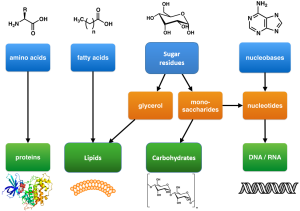Biological Macromolecules
Biological macromolecules are polymers or long chains of individual monomers or building blocks. In the following sections, you will learn about each macromolecule, their constituent monomers, and the mechanism by which the monomers come together to make up the macromolecule. Figure 3.1 nicely summarizes the connection between specific monomers and the macromolecules that they make up.

In the next few sections, you will have a chance to explore the general functions of each macromolecule type, broken out as follows:
- 3.1 Synthesis of Biological Macromolecules
- 3.2 Carbohydrate Structure and Function
- 3.3 Nucleic Acid Structure and Function
- 3.4 Protein Structure and Function
- 3.5 Lipid Structure and Function
Finally, in section 3.6 Career Connection, you’ll explore the roles and training of dietitians and nutritionists.
Video 3.1 below is a great introduction to the topic of biological macromolecules.
Video 3.0.1. Biomolecules by Amoeba Sisters
Figure Descriptions
Figure 3.0.1. The image is a flowchart detailing the relationships between biological molecules. At the top, four blue boxes represent “amino acids,” “fatty acids,” “Sugar residues,” and “nucleobases,” each with a chemical diagram above them. Arrows lead from these boxes to orange boxes in the middle labeled “glycerol,” “monosaccharides,” and “nucleotides,” suggesting the intermediate products formed from these initial components. Further arrows lead to green boxes at the bottom, labeled “proteins,” “Lipids,” “Carbohydrates,” and “DNA/RNA,” indicating end products. Associated with these are illustrative icons such as a protein structure model, a lipid bilayer diagram, a carbohydrate molecule, and a DNA double helix. [Return to Figure 3.0.1]
Media Attributions
- Building Blocks and Macromolecules © Boghog is licensed under a CC BY-SA (Attribution ShareAlike) license
